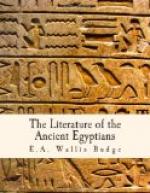The earliest known annals are found on a stone which is preserved in the Museum at Palermo, and which for this reason is called “The Palermo Stone”; the Egyptian text was first published by Signor A. Pellegrini in 1896. How the principal events of certain years of the reigns of kings from the Predynastic Period to the middle of the fifth dynasty are noted is shown by the following:
[Reign of] SENEFERU. Year ...
The building of Tuataua ships
of mer wood of a hundred capacity,
and 60 royal boats of sixteen
capacity.
Raid in the Land of the Blacks
(i.e. the Sudan), and the bringing
in of seven thousand prisoners,
men and women, and twenty thousand
cattle, sheep, and goats.
Building of the Wall of the
South and North [called] House of
Seneferu.
The bringing of forty ships
of cedar wood (or perhaps “laden with
cedar wood").
[Height of the Nile.] Two cubits, two fingers.
[Reign of Seneferu.] Year ...
The making of thirty-five ... 122 cattle
The construction of one Tuataua
ship of cedar wood of a hundred
capacity, and two ships of
mer wood of a hundred capacity.
The numbering for the seventh time.
[Height of the Nile.] Five cubits, one hand, one finger.
The royal historical inscriptions of the first eleven dynasties are very few, and their contents are meagre and unimportant. As specimens of historical documents of the twelfth dynasty the following may be quoted:
EDICT AGAINST THE BLACKS




